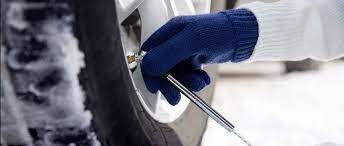There are two main reasons why tires lose pressure in cold weather.
First, let’s consider the materials of a tire. Tires are made of rubber, and rubber gets hard in cold weather. Harder rubber makes it more difficult for air to remain compressed inside the tire, which leads to air leaking out. The more air that leaks out, the lower your tire pressure goes.
Second, think about what happens when something is cooled down: it shrinks! Just like how ice cubes contract as they freeze (and expand again when they melt), the same principle applies to the air inside your tires. As the temperature drops, so does its volume—which means there’s less room for all that compressed air in your tires!
How much pressure do tires lose in cold weather?
- Tires lose pressure at a rate of 1-2 psi (pounds per square inch) for every 10 degrees Fahrenheit drop in temperature (that’s about 0.3 kg per cm2 for every 10 celsius, if you’re reading this from somewhere outside the U.S.).
- The older your tire, the faster it will lose pressure because as a tire ages, its rubber degrades and becomes weak. This is why tires should be replaced every six years regardless of their tread depth.
How to ensure your tires don’t lose pressure in cold weather
It hurts to think that you’re going around with tires that don’t provide the necessary air pressure: your car could be dangerously low on pressurized air at all times, and it’s even more dangerous if you’re driving over rough roads. If you thought the old days of keeping an eye on your tire pressure were a thing of the past, think again: there are plenty of easy ways to check on the pressures in your tires so your car doesn’t fall into a dangerous situation.
What should you do if your tire pressure is low?
The first thing to do is to check your tires for a slow leak. The most common causes of a slow leak are a nail in your tire that has loosened over time, or dry rot from too much exposure to the sun’s UV rays and heat. If you find that one of your tires is leaking air slowly, you will need to take it into a tire repair shop for inspection.
If you don’t notice any significant leaks, then you might not have anything major to worry about, but we still advise keeping an eye on things by taking out your tire pressure gauge and checking the pressure in all four tires. If one or more of your tires are low on air pressure, start driving around and try to get some miles under your belt while checking the pressure every couple hundred miles until they return back to normal levels. When checking on the status of your tires, make sure to look out for other potential problems like uneven wear or sidewall bulges that could indicate damaged sidewall cords or belts inside the tire. If you spot uneven wear patterns or notice any damage in these areas while inspecting your tires then pull into a service station immediately and have it looked at before continuing with your drive!
High-pressure tires are most likely to lose pressure in cold weather?
- Tires lose pressure when the temperature drops. When it gets colder, the air inside your tires contracts and causes pressure to drop. You may have noticed this in your own car’s tires before.
- High-pressure tires are the most affected by temperature changes because they have less volume for a given amount of pressure than other tires do, so they’re more sensitive to small changes. But if you have a low-pressure tire and it’s cold outside, you should still check its pressure every few days just in case.
Low-pressure tires are less likely to lose pressure in cold weather.
Low-pressure tires are less likely to lose pressure in cold weather. This is because they have a large amount of surface area that is in contact with the road. They also have more flexibility and can handle rough terrain better than high-pressure tires. The only downside is that they will wear out faster than higher-pressure tires on smooth surfaces such as freeways or highways.
Low tire pressure can affect your vehicle’s handling, fuel economy and safety.
Low tire pressure can affect your vehicle’s handling, fuel economy and safety.
- Handling: The contact patch of a tire that touches the road is important for steering and traction control. To improve stopping distances and increase vehicle control, tires need to have proper inflation. A low-inflated tire will have more contact with the road, which increases its ability to grip the road in wet conditions. However, too much of a good thing is bad! If your tires are under inflated, they will wear unevenly and lose their tread life faster.
- Fuel Economy: Under-inflated tires create excess rolling resistance by requiring more energy to flex or bend compared to an optimally inflated tire. Having low or high tire pressure can cause excessive rolling resistance from your tires, ultimately increasing fuel consumption and costs. Experts say that each time you add another 1 psi (pound per square inch), you save approximately 0.2% in fuel efficiency!
- Safety: Optimal pressure ensures stability in the sidewall of a tire (the part between the tread and rim). When there is insufficient air pressure, it causes additional stress on the sidewalls which can lead to irregular wear patterns or even blowouts while driving at a normal speed. Driving on any surface with low-air tires puts you at risk for poor handling response time if you need to stop quickly or make sharp turns on slippery roads during winter months.


